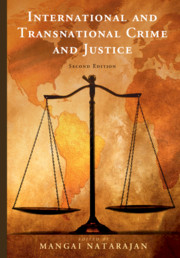Book contents
- International and Transnational Crime and Justice
- International and Transnational Crime and Justice
- Copyright page
- Contents
- Figures and Tables
- Preface
- About the Editor
- Notes on Contributors
- Introduction
- PART I OVERVIEW: TRANSNATIONAL CRIME
- PART IA Varieties of Transnational Crimes
- PART IB Transnational Organized Crime
- PART IC Factors that Facilitate Transnational Crimes
- PART ID Transnational Justice Matters
- PART II OVERVIEW: INTERNATIONAL CRIME
- PART III OVERVIEW: INTERNATIONAL AND TRANSNATIONAL CRIME RESEARCH
- World Map
- Index
- References
PART IA - Varieties of Transnational Crimes
from PART I - OVERVIEW: TRANSNATIONAL CRIME
Published online by Cambridge University Press: 20 June 2019
- International and Transnational Crime and Justice
- International and Transnational Crime and Justice
- Copyright page
- Contents
- Figures and Tables
- Preface
- About the Editor
- Notes on Contributors
- Introduction
- PART I OVERVIEW: TRANSNATIONAL CRIME
- PART IA Varieties of Transnational Crimes
- PART IB Transnational Organized Crime
- PART IC Factors that Facilitate Transnational Crimes
- PART ID Transnational Justice Matters
- PART II OVERVIEW: INTERNATIONAL CRIME
- PART III OVERVIEW: INTERNATIONAL AND TRANSNATIONAL CRIME RESEARCH
- World Map
- Index
- References
- Type
- Chapter
- Information
- Publisher: Cambridge University PressPrint publication year: 2019
References
REFERENCES
REFERENCES
WEBSITES
Anti-Slavery International. www.antislaveryinternational.org.
International Labour Organization. www.ilo.org.
International Organization for Migration (IOM). www.iom.int.
US Department of State Office to Monitor and Combat Trafficking in Persons. www.state.gov/g/tip.
United Nations Office on Drugs and Crime. www.unodc.org/unodc/en/human-trafficking/what-is-human-trafficking.html.
REFERENCES
IMPORTANT READING
REFERENCES
WEBSITES
UNODC Smuggling of Migrants Knowledge Portal. www.unodc.org/cld/en/v3/som/.
North Africa Mixed Migration Hub. www.mixedmigrationhub.org/.
Mixed Migration Monitoring Mechanism Initiative (4Mi). www.regionalmms.org/index.php/4mi-page/about-4mi.
Irregular Migration Research Database. https://gmdac.iom.int/research-database/.
IOM Migration Flows – Europe. http://migration.iom.int/europe/.
Missing Migrants Project. https://missingmigrants.iom.int/.
University of Queensland Migrant Smuggling Case Database. https://ssl.law.uq.edu.au/som-database/home.php.
European Border and Coast Guard Agency. https://frontex.europa.eu/.
REFERENCES
FURTHER READING
REFERENCES
REFERENCES
WEBSITES
Framework Convention Alliance (for a Framework Convention on Tobacco Control). www.ftct.org.
Action on Smoking and Health (anti-smoking NGO). www.ash.org.
The Center for Public Integrity (investigative journalists on the “Tobacco Underground”). www.publicintegrity.org/health/public-health/tobacco.
Tobacco Control (journal). http://tobaccocontrol.bmj.com.
Philip Morris International (tobacco manufacturer). www.philipmorrisinternational.com.
REFERENCES
WEBSITES
UNODC World Wildlife Crime Report 2016. www.unodc.org/documents/data-and-analysis/wildlife/World_Wildlife_Crime_Report_2016_final.pdf.
Centre for Conservation Criminology and Ecology. www.c3e.rutgers.edu.
TRAFFIC. www.traffic.org.
REFERENCES
REFERENCES
WEBSITES
Bitcoin blockchain explorer. blockchain.info.
Bitcoin wallet explorer. www.walletexplorer.com.
Dark web blogs. www.deepdotweb.com.
TNO dark web solutions. dws.pm.
TOR project. www.torproject.org.
REFERENCES
REFERENCES
WEBSITES
REFERENCES
REFERENCES
REFERENCES
WEBSITES
International Center for Missing and Exploited Children. www.icmec.org/.
Internet Watch Foundation. www.iwf.org.uk/.
INTERPOL: Crime Against Children. www.interpol.int/Crime-areas/Crimes-against-children/Crimes-against-children.
US Financial Coalition Against Child Pornography. www.icmec.org/fcacp/.
REFERENCES
WEBSITES
REFERENCES
REFERENCE
WEBSITES
International Transport Workers’ Federation (ITF). www.itfglobal.org/index.cfm.
International Maritime Organization (IMO). www.imo.org.
Paris MOU, the model cooperative port state inspection program. www.parismou.org.
ICC International Maritime Bureau (IMB). www.icc-ccs.org.
World Maritime News. www.worldmaritimenews.com.
REFERENCES
WEBSITES
International Maritime Bureau, Piracy Reporting Center. www.icc-ccs.org/piracy-reporting-centre.
Regional Cooperation Agreement on Combating Piracy and Armed Robbery against Ships in Asia (ReCAAP). www.recaap.org/.
Maritime Security Centre, Horn of Africa. www.mschoa.org/on-shore/home.
Center for Problem-Oriented Policing. popcenter.asu.edu/.
REFERENCES
REFERENCES
REFERENCES
WEBSITES
Transparency International. www.transparency.org/.
World Bank. www.worldbank.org.
United Nations Office on Drugs and Crime. www.unodc.org/unodc/en/corruption/index.html.
United Nations Convention against Corruption. www.unodc.org/pdf/corruption/publications_unodc_convention-e.pdf.
OECD Fighting Corruption. www.oecd.org/corruption.
Council of Europe GRECO (Group of States against Corruption). www.coe.int/t/dghl/monitoring/greco/default_en.asp.
U4 Anti-Corruption Resource Center. www.U4.no.



